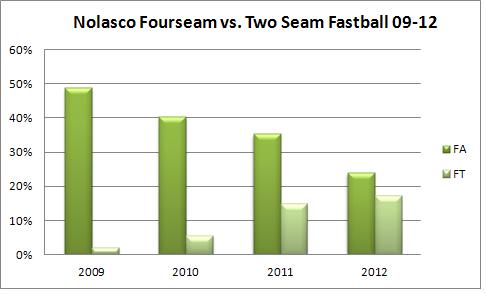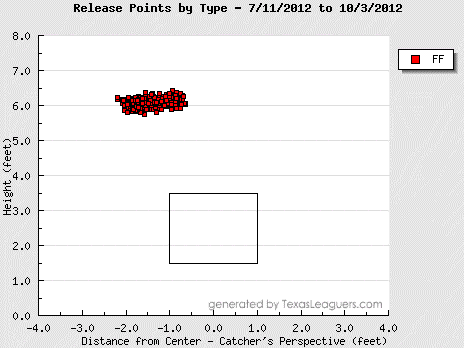Could Grass Be Greener for Ricky Nolasco?
In 2009, Ricky Nolasco was the poster boy for performing well below your predictors. His ERA ended at 5.06 while his FIP suggested 3.35. This disparity was in large part due to his high strikeouts and modest walk rate which collided with an abnormally low strand rate and piles of hits allowed. He was a classic buy low kind of guy in fantasy circles, with most expecting a major improvement in 2010.
Nolasco did improve, but not by a whole lot. And what’s happened since then is he has continued to underperform his FIP, and yet he has very much declined in performance. This can be summed up pretty quickly:
Nolasco went from a 9.49 K/9 and a 24.8% K rate to a 5.89 K/9 and 15% K rate in four years. That’s a huge drop off. Going with it, ever so slightly, is his velocity which has gone from 91.5 down to about 90.
What’s interesting is Nolasco has maintained his ERA right around 4.50 over the last three seasons, and his FIP hasn’t fluctuated that much either, regularly settling in under 4.0. And yet, you can barely recognize the pitcher from four seasons ago.
Nolasco has tinkered with his repertoire, leaning less on his four seam fastball while increasing usage of his two seamer:
The increased usage of the two seamer might be to blame for the precipitous drop in strikeout rates as he generates a measly 2.8% whiff rate on the pitch. The other result is he’s become much more of a ground ball pitcher, seeing his rate go from 38% to almost 47%.
Now, being a no-strikeout, ground ball kind of pitcher isn’t a terrible thing, but the Marlins weren’t particularly good on defense last year, and all of their options at third base were pretty disastrous. Based on his hit trajectory, his expected BABIP was .337 and his actual BABIP was only .309. Add to that what will likely be a questionable group of infielders in Miami in 2013, and you have a pretty unattractive recipe.
Beyond the declining strikeouts and modified repertoire, the strangest thing I unearthed looking at Nolasco is his release point on his pitches. I strung them together in a gif for comparison, so wait a few seconds on each (and thanks to Texasleaguers.com for the data and images).
Release points are typically tightly clustered, or if it’s not as a whole, at least each pitch type is. This is Nolasco’s 2011 release points for all pitches versus 2012:
First off, I love the unknown pitches that have release points somewhere over around third base. But 2012 is just a hot mess for release points. They’re all over the place, regardless of the pitch type. So out of curiosity, I just pared it down to a four seam fastball for clarity and then split it into halves over 2012:
Just what the hell is going on here? In the first half of 2012, he had a release point that resembled the one he had in 2011, but over the second half he moved his arm slot in dramatically. There was an uptick in velocity, but only about a half mile per hour, which is something you can typically expect over the course of the season for pitchers anyway (if not less than you would expect, actually). If you’re the optimistic type, it’s just an oddity. If you’re the suspicious type, this is either a desperate pitcher trying something new and/or a pitcher who is experiencing some discomfort in the old arm slot. You choose.
Of course, Nolasco has been in the news because of the fish selling off any of their contracts which people are willing to absorb, with Ricky being about the last one left in town. But you have to bet clubs are cognizant of his limitations and his trends. If he is dealt, he should hope it’s to a team with a terrific infield defense, a pitching coach with lots of savvy and patience, and a trainer with a table at the ready.
Michael was born in Massachusetts and grew up in the Seattle area but had nothing to do with the Heathcliff Slocumb trade although Boston fans are welcome to thank him. You can find him on twitter at @michaelcbarr.





How is being a low-strikeout, groundball pitcher not a terrible thing? There’s a clear relationship between high-babip and high groundball rates, which leads to lower strand rates, which obviously leads to more runs. All of which FIP doesn’t even look at, which is why FIP thinks he’s better than he is.
it’s not a terrible thing inasmuch as other pitchers have gotten away with it in the past, but it’s just not easy: Tim Hudson, Clayton Richard, Derek Lowe (the good Derek Lowe), etc. It’s certainly not a good thing, which is probably what I should have added.
I think it was meant in the sense, like, “at least he’s not a low K flyball guy”. Those guys are awful.
agreed, but don’t tell that to Chris Young and his surprisingly low 4.15 ERA! (0.38 GB:FB, 16.2 K%)